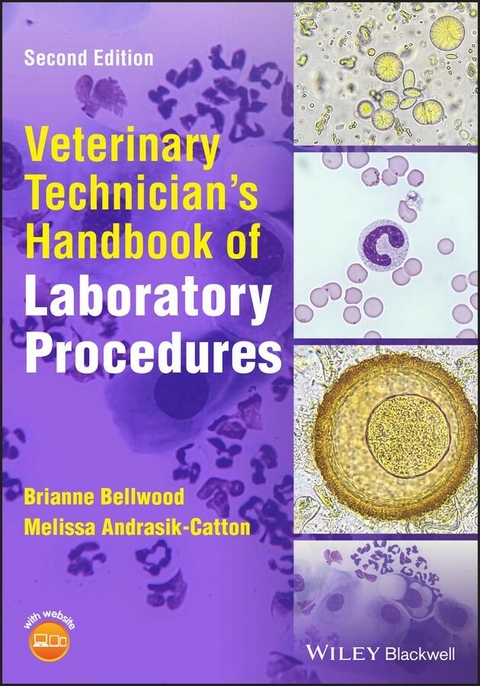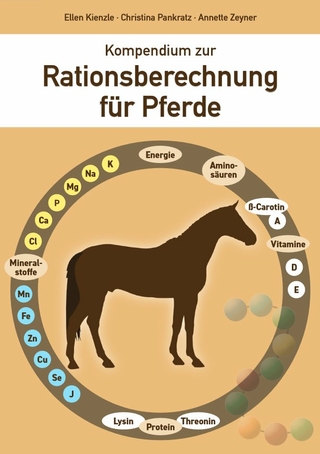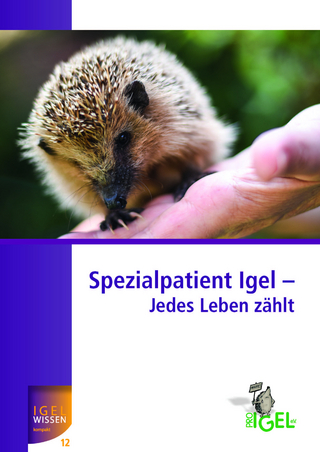
Veterinary Technician's Handbook of Laboratory Procedures
Wiley-Blackwell (Verlag)
978-1-119-67261-6 (ISBN)
The Second Edition of »Veterinary Technician’s Handbook of Laboratory Procedures« provides a significant update and expansion to the First Edition, with larger and better-quality images, more images overall, and significant updates to information and equipment throughout.
New chapters cover topics such as microbiology and parasitology, and the Second Edition newly covers quality assurance in the introductory chapter as well.
Now encompassing topics in all areas of clinical pathology, the book covers procedures in hematology, clinical chemistry, urinalysis, microbiology, parasitology, serology, and cytology. A companion website features case studies, crossword puzzles, figures from the book in PowerPoint, and additional figures not found in the book.
In »Veterinary Technician’s Handbook of Laboratory Procedures«, readers can expect to find helpful information on:
- Laboratory equipment, covering microscopes, centrifuges, refractometers, and chemistry, hematology, and coagulation analyzers
- Blood analysis, covering proper blood collection and handling techniques, blood collection tubes, blood smear preparation and staining, and hematology procedures
- Urinalysis procedures including the physical, chemical and sediment examination
- Cytology sample collection and smear preparation, covering the feather, line, squash, modified squash, and starfish methods, plus microscopic evaluation of cytology slides
- Identification of parasites, covering internal and external, plus protozoans
A helpful guide when performing many common laboratory tests and an excellent companion to full textbooks, »Veterinary Technician’s Handbook of Laboratory Procedures« is equally useful for veterinary technicians in training and in practice and has been carefully formatted and written to put the information veterinary technicians need at their fingertips.
Brianne Bellwood, MSc, RVT, VTS (Clinical Pathology), CCRVN, has been a full-time instructor for the Animal Health Technology program at Lakeland College in Vermilion, Alberta, Canada, since 2008.
Melissa Andrasik-Catton, RVT, BS, was a full-time instructor at Maple Woods Community College Veterinary Technology Program in Kansas City, Missouri, USA for 10 years and 8 additional years as an adjunct.
About the Authors xiv
About the Contributors xvii
Preface xviii
Acknowledgments xxi
Part 1 Patient Care Considerations 1
1 The Gold Standard, Standards of Care, and Spectrum of Care: An Evolving Approach to Diagnostic Medicine 3
Ryane E. Englar
1.1 Defining the Gold Standard 3
1.2 Limitations of the Gold Standard 4
1.3 Returning to the Case of the Cat with Stranguria: a Different Perspective on Standards of Care 4
1.4 Limitations to Standards of Care 5
1.5 Spectrum of Care 6
References 7
2 Consultation Room Communication Strategies that Facilitate Dialogue on the Diagnostic Approach to Patient Care 9
Ryane E. Englar
2.1 Emergence of Communication as a Clinically Relevant Skill in Human Health Care 9
2.2 The Evolution of Communication in Veterinary Health Care 10
2.3 Communication Skills That Are Essential to Diagnosis-Making 11
2.4 Concepts of Health Literacy and Compliance 13
2.5 Using Easy-to-Understand (Nonmedical) Language 14
2.6 Checking in 15
2.7 Assessing the Client’s Knowledge 17
2.8 Signposting 18
2.9 Addressing the Cost of Care 20
References 22
Part 2 Quick Assessment Tests (QATS) Involving Blood 27
3 Packed Cell Volume 29
Sharon M. Dial
3.1 Procedural Definition: What Is this Test About? 29
3.2 Procedural Purpose: Why Should I Perform this Test? 29
3.3 Equipment 29
3.4 Procedural Steps: How Do I Perform this Test? 30
3.5 Time Estimate to Perform Test 33
3.6 Procedural Tips and Troubleshooting 33
3.7 Interpreting Test Results 34
3.8 Clinical Case Example(s): Can We Link to the Cases in Chapter 5? 35
3.9 Add-On Tests That You May Need to Consider and Their Additive Value 35
3.10 Key Takeaways 36
References 36
4 Total Protein as Measured by Refractometry 37
Sharon M. Dial
4.1 Procedural Definition: What Is This Test About? 37
4.2 Procedural Purpose: Why Should I Perform this Test? 37
4.3 Equipment 38
4.4 Procedural Steps: How Do I Perform this Test? 38
4.5 Time Estimate to Perform Test 42
4.6 Procedural Tips and Troubleshooting 43
4.7 Interpreting Test Result 43
4.8 Clinical Case Example(s) 44
4.9 Add-On Tests That You May Need to Consider and Their Additive Values 44
4.10 Key Takeaways 44
Reference 45
Suggested References 45
5 Gross and Microscopic Evaluation of the Buffy Coat 46
Sharon M. Dial
5.1 Procedural Definition: What Is This Test About? 46
5.2 Procedural Purpose: Why Should I Perform this Test? 46
5.3 Equipment 47
5.4 Procedural Steps: How Do I Perform this Test? 47
5.5 Time Estimate to Perform Test 50
5.6 Procedural Tips and Troubleshooting 53
5.7 Interpreting Test Results 53
5.8 Clinical Case Example(s) 54
5.9 Add-On Tests That You May Need to Consider and Their Additive Value 54
5.10 Key Takeaways 54
Reference 54
6 The Blood Film 55
Sharon M. Dial
6.1 Procedural Definition: What Is This Test About? 55
6.2 Procedural Purpose: Why Should I Perform This Test? 55
6.3 Equipment 55
6.4 Procedural Steps: Preparing the Blood Film How Do I Perform This Test? 56
6.5 Time Estimate to Perform Test 64
6.6 Procedural Tips and Troubleshooting 64
6.7 Interpreting Test Results 69
6.8 Clinical Case Example(s) 70
6.9 Add-On Tests That You May Need to Consider and Their Additive Value 70
6.10 Key Takeaways 70
References 70
Suggested Bench-Side Reference 71
7 Blood Glucose 72
Sharon M. Dial
7.1 Procedural Definition: What Is This Test About? 72
7.2 Procedural Purpose: Why Should I Perform This Test? 72
7.3 Equipment 73
7.4 Procedural Steps: How Do I Perform This Test? 73
7.5 A Note on Quality Control 73
7.6 Procedure for Patient Samples 74
7.7 Time Estimate to Perform Test 76
7.8 Procedural Tips and Troubleshooting 76
7.9 Interpreting Test Results 77
7.10 Clinical Case Example(s) 78
7.11 Add-On Tests That you May Need to Consider and Their Additive Values 78
7.12 Key Takeaways 78
References 78
8 Blood Urea Nitrogen 79
Sharon M. Dial
8.1 Procedural Definition: What Is This Test About? 79
8.2 Procedural Purpose: Why Should I Perform This Test? 79
8.3 Equipment 80
8.4 Procedural Steps: How Do I Perform this Test? 80
8.5 Time Estimate to Perform Test 81
8.6 Procedural Tips and Troubleshooting 81
8.7 Interpreting Test Results 82
8.8 Clinical Case Example(s) 82
8.9 Add-On Tests That You May Need to Consider and Their Additive Value 82
8.10 Key Takeaways 83
9 Whole Blood Lactate 84
Sharon M. Dial
9.1 Procedural Definition: What Is This Test About? 84
9.2 Procedural Purpose: Why Should I Perform This Test? 84
9.3 Equipment 85
9.4 Procedural Steps: How Do I Perform This Test? 85
9.5 A Note on Quality Control 85
9.6 Procedure for Patient Samples 85
9.7 Time Estimate to Perform Test 87
9.8 Procedural Tips and Troubleshooting 87
9.9 Interpreting Test Results 87
9.10 Clinical Case Example(s) 88
9.11 Add-On Tests That You May Need to Consider and Their Additive Value 88
9.12 Key Takeaways 88
References 88
10 Saline Agglutination Test 89
Sharon M. Dial
10.1 Procedural Definition: What Is This Test About? 89
10.2 Procedural Purpose: Why Should I Perform This Test? 89
10.3 Equipment 89
10.4 Procedural Steps: How Do I Perform This Test? 89
10.5 Time Estimate to Perform Test 91
10.6 Procedural Tips and Troubleshooting 91
10.7 Interpreting Test Results 92
10.8 Clinical Case Example(s) 92
10.9 Add-On Tests That You May Need to Consider and Their Additive Value 92
10.10 Key Takeaways 92
Reference 93
11 Activated Clotting Time 94
Sharon M. Dial
11.1 Procedural Definition: (“What Is This Test About?”) 94
11.2 Procedural Purpose: Why Should I Perform This Test? 94
11.3 Equipment 94
11.4 Procedural Steps: How Do I Perform This Test? 94
11.5 Time Estimate To Perform Test 96
11.6 Procedural Tips and Troubleshooting 97
11.7 Interpreting Test Results 97
11.8 Clinical Case Example(s) 97
11.9 Add-On Tests That You May Need to Consider and Their Additive Value 97
11.10 Key Takeaways 97
Part 3 Quick Assessment Tests (QATS) Involving Urine 99
12 Assessing Urine’s Physical Properties 101
Ryane E. Englar
12.1 Procedural Definition: What Is This Test About? 101
12.2 Procedural Purpose: Why Should I Perform This Test? 101
12.3 Equipment 102
12.4 Procedural Steps 103
12.5 Time Estimate to Perform Test 105
12.6 Procedural Tips and Troubleshooting 105
12.7 Interpreting Test Results 106
12.8 Clinical Case Example(s) 111
12.9 Add-On Tests That You May Need to Consider and Their Additive Value 113
12.10 Key Takeaways 113
12.11 Clinical Pearls 114
References 115
13 Urine Specific Gravity 116
Ryane E. Englar
13.1 Procedural Definition: What Is This Test About? 116
13.2 Procedural Purpose: Why Should I Perform this Test? 117
13.3 Equipment 117
13.4 Procedural Steps 118
13.5 Time Estimate to Perform Test 124
13.6 Procedural Tips and Troubleshooting 124
13.7 Interpreting Test Results 124
13.8 Clinical Case Example(s) 126
13.9 Add-On Tests That You May Need to Consider and Their Additive Value 127
13.10 Key Takeaways 127
13.11 Clinical Pearls 127
References 128
14 Chemical Evaluation of Urine 130
Ryane E. Englar
14.1 Procedural Definition: What Is This Test About? 130
14.2 Procedural Purpose: Why Should I Perform This Test? 132
14.3 Equipment 132
14.4 Procedural Steps 132
14.5 Time Estimate to Perform Test 136
14.6 Procedural Tips and Troubleshooting 136
14.7 Interpreting Test Results 138
14.8 Clinical Case Example(s) 141
14.9 Add-On Tests That You May Need to Consider and Their Additive Value 142
14.10 Key Takeaways 143
14.11 Clinical Pearls 144
References 145
15 Urine Sediment Examination 146
Sharon M. Dial
15.1 Procedural Definition: What Is This Test About? 146
15.2 Procedural Purpose: Why Should I Perform This Test? 146
15.3 Equipment 147
15.4 Procedural Steps: How Do I Perform This Test? 147
15.5 Time Estimate to Perform Test 149
15.6 Procedural Tips and Troubleshooting 151
15.7 Interpreting Test Results 152
15.8 Clinical Case Example(s) 157
15.9 Add-On Tests That You May Need to Consider and Their Additive Value 157
15.10 Key Takeaways 157
Reference 157
Suggested Bench-Side References 158
Part 4 Quick Assessment Tests (QATS) Involving Feces 159
16 Assessing the Physical Properties of Fecal Matter 161
Ryane E. Englar
16.1 Procedural Definition: What Is This Test About? 161
16.2 Procedural Purpose: Why Should I Perform This Test? 161
16.3 Equipment 164
16.4 Procedural Steps 166
16.5 Time Estimate to Perform Test 166
16.6 Procedural Tips and Troubleshooting 166
16.7 Interpreting Test Results 172
16.8 Clinical Case Example(s) 183
16.9 Add-On Tests That You May Need to Consider and Their Additive Value 183
16.10 Key Takeaways 185
16.11 Clinical Pearls 186
References 187
17 Direct Smears 191
Ryane E. Englar
17.1 Procedural Definition: What Is This Test About? 191
17.2 Procedural Purpose: Why Should I Perform This Test? 191
17.3 Equipment 194
17.4 Procedural Steps [1–5, 20, 30, 60–62] 194
17.5 Time Estimate to Perform Test 196
17.6 Procedural Tips and Troubleshooting 196
17.7 Interpreting Test Results 197
17.8 Clinical Case Example(s) 198
17.9 Add-On Tests That You May Need to Consider and Their Additive Value 201
17.10 Key Takeaways 203
17.11 Clinical Pearls 204
References 204
18 Fecal Flotation 207
Ryane E. Englar and Jeremy Bessett
18.1 Procedural Definition: What is This Test About? 207
18.2 Procedural Purpose: Why Should I Perform This Test? 210
18.3 Options Available for Fecal Flotation 211
18.4 Equipment 213
18.6 Time Estimate to Perform Fecal Flotation with Fixed-Angle Centrifuge 216
18.7 Brief Consideration of the Procedural Steps in the Event a Swinging Bucket Centrifuge Is Used 217
18.8 Equipment 217
18.9 Procedural Steps 217
18.10 Time Estimate to Perform Passive Fecal Flotation 221
18.11 Procedural Tips and Troubleshooting for Fecal Flotation 221
18.12 Interpreting Test Results 221
18.13 Clinical Case Example(s) 227
18.14 Add-On Tests That You May Need to Consider and Their Additive Value 227
18.15 Key Takeaways 229
18.16 Clinical Pearls 229
References 230
Part 5 Quick Assessment of Body Cavity Fluids 235
19 Body Cavity Fluid Analysis 237
Sharon M. Dial
19.1 Procedural Definition: What Is This Test About? 237
19.2 Procedural Purpose: Why Should I Perform This Test? 237
19.3 Equipment 238
19.4 Procedural Steps: How Do I Perform This Test? 238
19.5 Time Estimate to Perform Test 240
19.6 Procedural Tips and Troubleshooting 240
19.7 Interpreting Test Results 241
19.8 Clinical Case Example(s) 244
19.9 Add-On Tests That You May Need to Consider and Their Additive Value 244
19.10 Key Takeaways 245
References 245
Suggested Bench-Side References 245
Part 6 Clinical Cases 247
20 Clinical Cases 249
Jeremy Bessett, with support from Sharon M. Dial
Case 1: Fred 249
Case 2: Bella 253
Case 3: Benji 258
Case 4: Mittens 266
Case 5: Star 272
Case 6: Earl 277
Case 7: Sammy 281
Case 8: Coffee 286
Case 9: Dexter 291
Case 10: Tabitha 297
Case 11: Ace 301
Case 12: Timothy 304
Case 13: Duckie 307
Case 14: Angel 311
Case 15: Chase 314
Index 321
| Erscheinungsdatum | 07.02.2023 |
|---|---|
| Verlagsort | Hoboken |
| Sprache | englisch |
| Gewicht | 666 g |
| Einbandart | kartoniert |
| Themenwelt | Veterinärmedizin ► Allgemein ► Tiermedizinische Fachangestellte |
| Veterinärmedizin ► Kleintier | |
| ISBN-10 | 1-119-67261-9 / 1119672619 |
| ISBN-13 | 978-1-119-67261-6 / 9781119672616 |
| Zustand | Neuware |
| Informationen gemäß Produktsicherheitsverordnung (GPSR) | |
| Haben Sie eine Frage zum Produkt? |
aus dem Bereich


